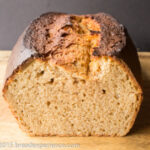Description
This Sourdough Sweet Potato Bread is a unique mashup of sweet potato, red lentil flour, bread flour and a hint of cinnamon.
Ingredients
- 65 grams active sourdough starter (100% hydration) **See Notes**
- 130 grams cooked sweet potatoes, mashed
- 250 grams milk, scalded, then cooled
- 40 grams honey
- 50 grams butter, softened
- 65 grams red lentil flour (grind red lentils in a grain mill, coffee grinder, or high-powered blender)
- 465 grams bread flour
- 2 tsp. cinnamon
- 65 grams water, if needed – I used potato water
- 10 grams sea salt
- 25 grams water, if needed to dissolve salt
- Milk or egg for wash
Instructions
Day 1: Prepare the Dough
- Cook the sweet potatoes, let cool. Reserve the potato water in case extra hydration is needed. (I ended up with 65 grams of potato water. You may have more or less.)
- Scald the milk, then let it cool to room temperature.
- Add the sourdough to a large mixing bowl and add in the rest of the wet ingredients except the potato water. Stir well.
- Whisk together all of the dry ingredients except the salt.
- Add the dry ingredients to the wet ingredients and mix using a wooden spoon or Danish dough whisk.
- Add the reserved potato water, a little at a time, if the dough is too dry.
- Mix thoroughly until a sticky mass forms
- Cover and allow the dough to autolyse for 20 – 30 minutes until the flour is fully hydrated.
- Sprinkle the salt over the dough and add the additional 25 grams of water, if needed to fully dissolve the salt and work it into the dough.
- Remove the dough to a counter and knead until it is soft and pliable – about 5 to 7 minutes.
- Place the dough in a clean, lighted oiled bowl, and cover with plastic wrap, or bees wrap.
- Let it bulk ferment for 5 hours at room temperature or until almost doubled in size and continue with the shaping and final proof.
- Alternately, let the dough bulk ferment for 2 – 3 hours, then place in the refrigerator overnight. (This is the method I used.)
Day 2: Shape, Final Proof and Bake the Loaf
- The next day, remove the dough from the refrigerator and allow it to warm up to room temperature, about 2 -3 hours, depending on the temperature in your kitchen.
- Place the dough on a lightly-floured counter and press into a (6 x 8 inch) rectangle.
- Fold the top down to the center and press tightly to form surface tension.
- Fold the bottom up to the center and press tightly to form surface tension.
- Lightly tuck the ends of the loaf under and place the loaf seam-side down in a greased loaf pan. (I used a stoneware 9 x 5-inch loaf pan. A 9 – 10-inch non stick or ceramic loaf pan would work as well.)
- Allow the loaf to proof for 2 -3 hours until it reaches the top of the pan.
- Preheat the oven to 400 degrees F. (See notes)
- Brush the top of the loaf with an egg or milk wash using a pastry brush.
- Score the loaf straight down the middle about 1/4 to 1/2-inch deep using a lame or sharp knife.
- Place the loaf in the preheated oven and let it bake for about 35 to 40 minutes, or until the top is a deep brown color. Tent the top with foil if the top starts to brown too quickly.
- Cool completely before slicing. Waiting 24 hours is even better to allow the flavor to develop and the crumb to set.
Notes
I preheated the oven to 425 degrees F. and after placing the loaf in the oven, reduced the temperature to 400 degrees F. As a result, the top of the loaf got a bit too dark. This didn’t affect the flavor of the loaf, but if you prefer a deep brown and not a dark brown, I recommend either tenting the loaf partway through the bake cycle or bake at a lower temperature.
If you don’t have a sourdough starter:
1) You can create one from scratch. It will take several days before you can use it in this recipe. My favorite is this one https://www.breadexperience.com/you-are-apple-of-my-starter/
Or
2) Use dried yeast instead. Add 1/2 teaspoon of instant dried yeast to the dry ingredients. Allow the dough to bulk ferment overnight (8-12 hours) in the refrigerator. If you want to ferment the dough longer, use less yeast – about 1/4 tsp.
- Category: Sweet Potato Bread
- Cuisine: Naturally Leavened Bread
